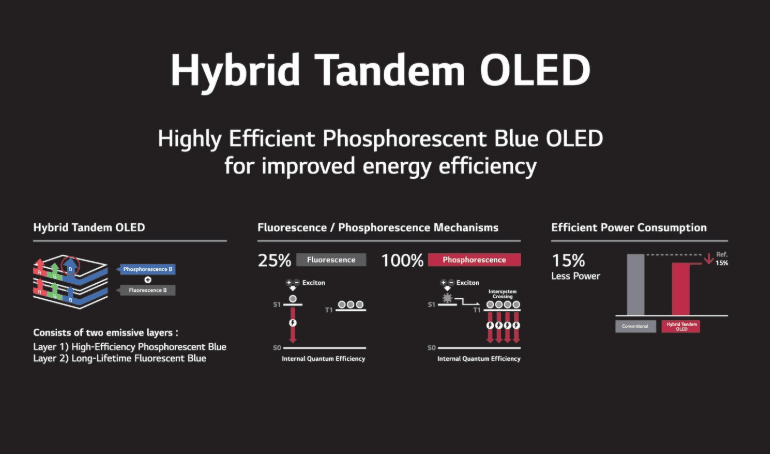
LG Display says it has completed a major milestone in its push to develop fully phosphorescent OLED panels, paving the way for OLED displays with much greater energy efficiency.
The company has just verified the commercialisation of a new prototype panel that uses blue phosphorescent PHOLED material, making it the first OLED display in the world to utilise PHOLED materials for all three primary colours - blue, red and green.
When it comes to OLED panels, there are two kinds of organic materials that can be used to create the red, green and blue pixels. Companies can use either fluorescent or phosphorescent materials, but while the former is much easier to manufacture and work with, it’s not nearly as efficient as the latter.
That explains why display makers have been racing to develop a fully phosphorescent OLED, or PHOLED panel for years. They cracked green and red PHOLED more than 20 years ago, but until now, their efforts have always come a cropper when trying to develop a viable blue PHOLED material.
Creating blue PHOLED has been challenging because it has by far the shortest wavelength among the three primary colours, and it also requires greater energy.
However, LG Display says it has finally made a breakthrough by implementing a new, hybrid two-stack Tandem OLED structure, which uses blue fluorescence in the lower stack, and blue phosphorescence in the upper stack.
It’s believed that an OLED panel that’s made from 100% PHOLED materials will exhibit energy efficiency of 99%, meaning that almost all of the electrical power going into the panel will be transformed into light, with hardly any being emitted as heat. That would mean super bright OLED panels with astonishingly low power consumption.
LG Display isn’t quite there yet, and the fact it still uses blue fluorescence in the lower stack means it can only deliver a 15% energy savings boost over today’s OLED panels, which use blue fluorescence materials throughout the entire stack. Nonetheless, it’s a big step in the direction towards a “dream OLED” display that can attain 99% energy efficiency., the company said.
When LG Display says it has managed to “successfully verify the commercialisation-level performance of blue phosphorescent OLED panels on a mass production line”, what it means is it has verified the processability, performance evaluation and optical characteristics of the panel on a mass production line.
The company says it has independently filed patents for its new OLED panel featuring blue PHOLED materials in both the U.S. and South Korea. The next step will be to showcase the new panel, and it’s planning to do this at the SID Display Week 2025 event that kicks off on May 11 in San Jose, California.

The company said the first panels to utilise blue PHOLED will be for small and medium-sized devices, such as smartphones, tablets and laptops. The new panel is ideal for these kinds of devices, as the increased energy efficiency can lead to much longer battery lifetimes. After all, it’s the display that eats up most of the energy consumed by these devices.
LG Display has been collaborating with a company called Universal Display Corporation on the new OLED display. UDC first announced it had managed to create a viable blue phosphorescent material back in December 2022, and it has been working with LG Display ever since then to try and integrate it into its OLED stack.
UDC is also believed to be working with Samsung Display, which is said to be especially interested in blue PHOLED because its QD-OLED displays are mostly made up of blue pixels. Instead of using red and green pixels, they make use of a quantum dot layer that transforms blue light into red and green. However, Samsung Display has not yet made any announcements regarding blue PHOLED, and it’s not clear how far its development has come.
LG Display’s immediate goal will be to showcase the benefits of its new PHOLED panel and convince customers to start buying it. But in the longer term, the goal is to build an OLED panel that’s made up of 100% PHOLED material. Once that’s done, the company will then want to scale it up to create larger PHOLED panels for televisions.
While battery life is not a concern for TVs, an OLED panel that runs cooler should be able to achieve much higher brightness and maintain that performance for longer, without degrading the pixels.
If LG Display – or Samsung Display, for that matter – can do this, we would get OLED TVs that are every bit as capable as the brightest Mini-LED televisions in brightly lit rooms. At present, higher brightness is one of the few remaining advantages Mini-LED retains over OLED panels.
LG Display Chief Technology Officer and Executive Vice President Soo-young Yoon said the successful commercialisation of blue phosphorescence technology represents the “final piece” of the Dream OLED puzzle.
While that’s not entirely true - as the final piece is actually a 100% PHOLED panel, Yoon said he’s confident that it’s enough to “secure a leading position in the future display market” for years to come.